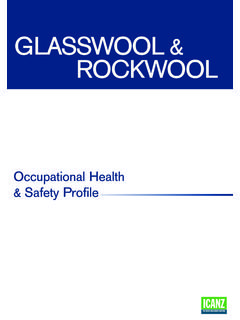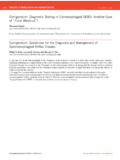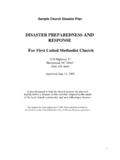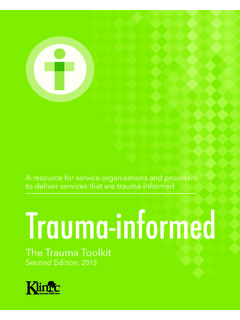Transcription of ICANZ FBS-1 Insulation Rockwool MSDS 070509[1]
1 MSDS for FBS-1 Insulation Rockwool Page 1 of 4 MATERIAL safety DATA SHEET FBS-1 Insulation Rockwool Non-Hazardous Substance Non-Dangerous Goods SECTION 1: IDENTIFICATION OF THE MATERIAL AND SUPPLIER Product Name: FBS-1 Insulation Rockwool Other Names: FBS-1 Insulation Rockwool is made up into many Insulation products having individual trade names. Typically it is supplied in the form of batts, slabs, tiles or sheets. Recommended Use: Thermal and acoustic Insulation , and energy conservation. Used in homes, public and commercial buildings, warehouses, industrial and petrochemical plants, motor vehicles, ships, public transport, power stations and white goods. Supplier: Insulation Council of Australia and New Zealand ( ICANZ ) Address: Suite 201, Level 2, 18 Kavanagh St, Southbank VIC 3006 Telephone: 1300 363 742 (within Australia only), or 61 3 9929 4150 Email address: Website: Emergency contact: 000 Fire Brigade and Police or 13 11 26 Poisons Information Centre (available in Australia only) Because FBS-1 Insulation Rockwool products manufactured in Australia and New Zealand by member companies of ICANZ are classified as NON-HAZARDOUS, a Material safety Data Sheet (MSDS) is not strictly required under Australian Regulations.
2 This model MSDS is issued by ICANZ for the information of users, installers and the community. It has been formatted in accordance with the Code on Preparation of a Material safety Data Sheet 2003 Safe Work Australia (SWA formerly ASCC/NOHSC). The suppliers of these products also issue their own MSDS which reflect the health & safety information in this sheet and contain other product-specific information. Individual MSDS are available from suppliers websites, or on request. The health & safety information for these products must not be altered, deleted or added to. SECTION 2: HAZARDS IDENTIFICATION STATEMENT OF HAZARDOUS NATURE: Classified as Non-Hazardous according to the criteria of the Australian safety and Compensation Council ASCC (formerly NOHSC) Approved Criteria For Classifying Hazardous Substances [NOHSC: 1008] 3rd Edition.
3 FBS-1 Insulation Rockwool is classified as Non-Dangerous Goods according to the Australian Code for the Transport of Dangerous Goods by Road and Rail. SECTION 3: COMPOSITION / INFORMATION ON INGREDIENTS Chemical Name: Proportion: CAS Number: Mineral Rockwool fibre (amorphous, non-crystalline, bio-soluble Note Q applicable) >85% - Heat-cured resin (fibre binding agent) <15% 25104-55-6 Mineral oil (solvent-refined dust suppression agent) <1% - Note: Traces (< ) of volatile original components of resin may remain in recently manufactured product. SECTION 4: FIRST AID MEASURES Swallowed: Rinse lips and mouth with water. Eye: Flush with clean water. If discomfort persists, seek medical attention. Skin: Flush off with water, preferably running. If itch or discomfort persists, seek medical attention.
4 Inhaled: Remove to fresh air. If symptoms persist, seek medical attention. Advice to doctor: Any symptoms and signs of ill-health are likely to be due to other causes. Can be slightly itchy on prolonged contact with skin. Does not produce any acute or chronic health effects. Treatment should be directed toward cleansing the skin and symptomatic treatment as necessary. MSDS for FBS-1 Insulation Rockwool Page 2 of 4 SECTION 5: FIRE FIGHTING MEASURES Flammability: Non flammable, will not burn. Suitable Extinguishing Media: As needed for surrounding fire conditions. Any extinguishing media may be used as required. Waterfog may be used to cool intact containers and nearby storage areas. Hazards from combustion products: FBS-1 Insulation Rockwool is non-flammable, but the plastic wrapping, resin binder, and some facings may decompose, smoulder or burn in a fire or when heated above 300 C.
5 If product is present in a fire, toxic gases or smoke may be evolved depending on surrounding fire conditions. Fire Fighting Procedures: As needed for surrounding fire conditions. If required, evacuate area and contact emergency services; remain upwind and notify those downwind of fire hazard; and wear protective equipment including Self-Contained Breathing Apparatus (SCBA). HAZCHEM Code: None allocated. SECTION 6: ACCIDENTAL RELEASE MEASURES Containment Procedure: If product is torn or loose, cover or reseal to minimise fibre release. Reuse where possible or place in a sealable plastic bag for disposal according to local authority guidelines. Clean Up Procedure: Personnel directly involved in clean-up of loose material should wear personal protective equipment as described in Section 8.
6 Clean area so as to avoid dispersion of loose material or fibres using wet sweep methods or vacuum cleaner. SECTION 7: HANDLING & STORAGE Handling: These products are safe in use. Once installed, the product does not release dust or fibres. Handling, installing or removing the product may result in some dust and airborne fibre. Minimise eye or skin contact and inhalation during handling, installation and removal (see Section 8). Observe good personal hygiene, including washing hands before eating. Remove personal protective equipment before entering eating areas. Storage: Store in sealed container in cool dry area, removed from foodstuffs. Ensure packages are adequately labelled, protected from physical damage, and sealed when not in use. Avoid packaging being stored under UV light (direct sunlight) for long periods.
7 Incompatibilities: None SECTION 8: EXPOSURE CONTROLS / PERSONAL PROTECTION Exposure Standards: None allocated for FBS-1 Insulation Rockwool products, which may be regarded as nuisance dusts. ICANZ recommends following the National Occupational Exposure Standard (NES) Australian safety and Compensation Council, ASCC (formerly NOHSC) general guide to keep all occupational exposures to dust and other atmospheric contaminants to as low a level as is workable (practicable). For non-hazardous nuisance dusts: mg/m3 TWA for inspirable dusts and/or 10 mg/m3 TWA for total dust (of any type, or particle size) is recommended. TWA is the time-weighted average airborne concentration over an 8-hour working day, for a 5-day working week over an entire working life. According to current knowledge this concentration should neither impair the health of, nor cause undue discomfort to, nearly all workers.
8 Engineering Controls, Ventilation: During most applications and installation no special ventilation will be required. However, if installing in dusty or poorly-ventilated areas, or during the first heat-up cycle in high-temperature applications, local exhaust ventilation should be considered. Work practices should aim to minimise the release of, and exposure to, fibres and/or dust. Hand tools generate the least amount of dust and fibres. If power tools are used directly on the product appropriate dust collection systems are recommended. Work areas should be cleaned regularly, and vacuuming or wet sweeping is recommended. Personal Protection Skin Protection: Direct skin contact can be minimised by wearing long-sleeved shirts and long trousers, a cap or hat, and standard duty gloves conforming to Australian Standard AS 2161.
9 Work clothes should be washed regularly and separately from other clothes. Eye Protection: When handling these products, particularly overhead or in enclosed or poorly-ventilated areas such as ceiling spaces or risers, eye contact with dust or fibre can be avoided by wearing ventilated non-fogging dust-resistant goggles conforming to Australian and New Zealand Standards AS/NZS 1336. MSDS for FBS-1 Insulation Rockwool Page 3 of 4 Respiratory Protection: None normally required. If dust is generated in enclosed or poorly-ventilated areas, an approved particulate respirator conforming to Australian and New Zealand Standards AS/NZS 1715 and 1716 is recommended. P1, P2 or N95 type respirators are appropriate. Use only respirators that bear the Australian Standards mark and are fitted and maintained correctly, and kept in clean storage when not in use.
10 Personal Hygiene: Washing of exposed skin with soap and water at the end of a shift or as required is recommended as a comfort measure. SECTION 9: PHYSICAL AND CHEMICAL PROPERTIES Appearance: A matt of fibrous material resembling wool. It is supplied in different shapes and sizes, in outer packaging. It may be rigid or flexible, and facings such as aluminium foil, vinyl, and synthetic tissues applied to meet specific purposes. Odour: Slight amine/sour odour, particularly when recently manufactured, then odourless pH: Not applicable Boiling Point: Not applicable Melting Point: > 704 C Vapour Pressure/Density: Not applicable Specific Gravity (H2O = 1) Generally low, but variable depending on facings Solubility in water: Insoluble Volatile Organic Compounds (VOC) Content / % Volatiles: Very low; <1% (as specified by the Green Building Council of Australia) Flash Point: Not applicable Decomposition Temperature: > 300 C Lower/Upper Explosive Limits: Not applicable SECTION 10: STABILITY AND REACTIVITY Chemical Stability: Stable.
![ICANZ FBS-1 Insulation Glasswool MSDS 0700509[1]](/cache/preview/4/6/b/a/3/8/3/1/thumb-46ba3831ee10fb6166d7a04167a36416.jpg)











